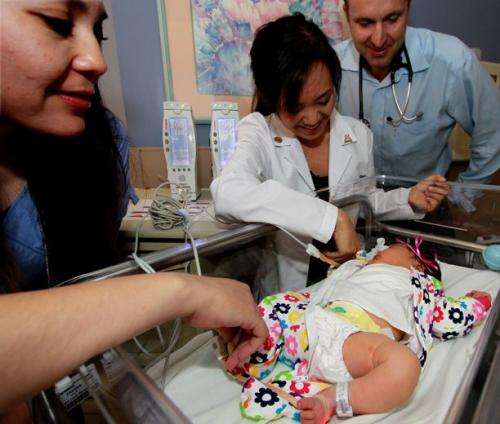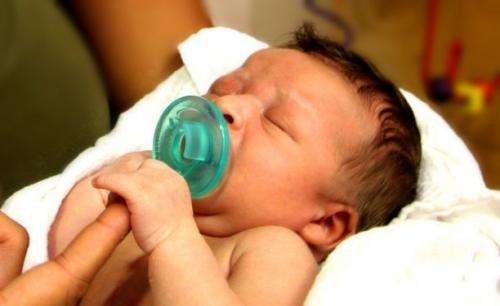Research determines feasibility of newborn screening

Research by UA medical student Lucy Han finds that implementing recommended pulse oximetry screening guidelines is feasible at Tucson's elevation. A recent simple pulse oximetry test revealed a potentially life-threatening critical congenital heart defect in a newborn that was surgically repaired at The University of Arizona Medical Center-University Campus.
A study conducted by University of Arizona College of Medicine-Tucson student Lucy Han evaluated pulse oximetry readings of newborns at The University of Arizona Medical Center-University Campus and found low false-positive results at Tucson's elevation – establishing that implementing recommended pulse oximetry screening guidelines is feasible.
Pulse oximetry is a non-invasive, painless and inexpensive test conducted on newborns after 24 hours of life to measure the percentage of oxygen saturation in the blood. Low saturation levels indicate a possible congenital heart problem, which may result in congestive heart failure or even death.
Babies born with critical congenital heart disease, or CCHD, may not have signs of a heart problem until after they leave the hospital, typically within the first four weeks of life. This is why pulse oximetry is considered such an important and necessary screening: If detected early, CCHD can be diagnosed and treated, improving outcomes.
In 2011, recommendations for newborn pulse oximetry screening of CCHD were made by the U.S. Health and Human Services Secretary's Advisory Committee on Heritable Disorders in Newborns and Children, or SACHDNC, the American Academy of Pediatrics, the American College of Cardiology Foundation and the American Heart Association.
The recommendations were based on research findings that had been conducted in regions at or just above sea level, causing concern that the established protocols – if followed in areas of higher elevation – might result in high rates of false-positives, causing unnecessary stress on the health-care system from additional tests required to verify CCHD in newborns.
"Arizona is one of 13 states that have not yet adopted this screening as a mandate, with elevation and the potential of false positives being two of many issues the state needs to consider," said Dr. Scott Klewer, a professor in the UA department of pediatrics and a researcher with the Steele Children's Research Center.
"The oxygen concentration in the air is lower at higher elevations," said Klewer. "This has led to concerns that the recommended 'cut-off' levels for a positive pulse oximetry screen (<95 percent) might include too many normal babies born at higher elevations in the mountain states that would require unnecessary additional testing for CCHD."

To address the elevation and false-positive issues, UA medical student Lucy Han, working with her mentor, pediatric cardiologist Dr. Brent Barber, an associate professor with the UA department of pediatrics, conducted a research study to evaluate the feasibility of implementing the U.S. SACHDNC recommended pulse oximetry screening protocol in Tucson, with its elevation at 2,643 feet.
Han's study was funded by the Medical Student Research Program at the UA College of Medicine-Tucson. Han and Barber worked with the staff at UAMC's newborn nursery, evaluating the pulse oximetry readings of 1,069 newborns in 2012.
The findings of the study, "Feasibility of Pulse Oximetry Screening for Critical Congenital Heart Disease at 2643-Foot Elevation," published in the May issue of Pediatric Cardiology, established that implementing the screening guidelines recommended by the U.S. SACHDNC is feasible at an elevation of 2,643 feet with low false-positive rates.
"This is significant," said Barber, "because now we have evidence that the protocol works at our elevation, and we can confidently continue pulse oximetry screenings using the existing recommendations without the fear of false-positive readings based on our elevation.
"It was a pleasure to work with Lucy on this research," said Barber. "She took an active role in this project and saw it to its completion. Lucy gave an outstanding and well-received presentation of our research at a national meeting, the Western Society of Pediatric Research in January, and was the lead author for the manuscript recently published in Pediatric Cardiology. Lucy is a highly motivated and bright student-scientist."
"I was amazed at how supportive both the hospital staff and parents were in implementing the pulse oximetry protocol, and I think it will be a great addition to the current newborn screening process," said Han.
Pulse oximetry screening has been standard procedure in the newborn nursery at UAMC since 2006. The hospital was the first in Tucson to adopt pulse oximetry screening, based on research by then pediatric resident Dr. Michael Seckeler. Seckeler conducted a pilot study funded by the University of Arizona Sarver Heart Center and overseen by his mentor, Klewer. The results of the study provided evidence to the efficacy of employing pulse oximetry as a universal screening test to detect CCHD.
Indeed, a routine pulse oximetry test recently revealed a potentially life-threatening CCHD in a newborn boy. Gabriel Blair, born April 22, was scheduled to be discharged from the newborn nursery at UAMC – when the test showed he had very low oxygen saturation of 70-80 percent (normal range is greater than 95 percent).
A subsequent echocardiogram conducted by Klewer revealed that Gabriel had a type of CCHD known as total anomalous pulmonary venus return, or TAPVR, in which the four veins that transport blood from the lungs to the heart are not connected normally to the left atrium. Instead, they are re-directed to the right atrium. This prevents oxygen-rich (red) blood from passing from the left atrium to the left ventricle and on to the body as it should. Instead, oxygen-rich (red) blood returns to the right side of the heart rather than the left atrium, mixing with blue blood in the right atrium. TAPVR requires surgery to correct.
"Gabriel looked healthy, was breathing fine, eating well and we were about to go home," said his mom, Emily Stiffe. "Thankfully, the pulse oximetry test detected an issue, which led to the early diagnosis of TAPVR."
Pediatric cardiothoracic surgeon Dr. Michael Teodori, a professor in the UA department of surgery, repaired Gabriel's heart defect with open-heart surgery on April 26. He was discharged from the Neonatal Intensive Care Unit at The University of Arizona Medical Center-Diamond Children's on May 3 and received a follow-up exam at the Arizona Elks Clinic for Children and Young Adults at UAMC when he was 18 days old.
Said Stiffe: "He is doing very well."
More information: link.springer.com/article/10.1 … 07/s00246-013-0716-2













